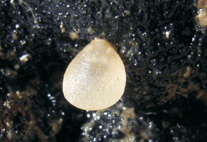Abstract
New Recent very small but sexually mature brachiopods have been found at abyssal depths (4580–4850 m) in the Clarion- Clipperton Zone of the Pacific Ocean. They are characterized by simple (under-developed, juvenile) morphological fea-tures, which are interpreted here as paedomorphic, indicating the importance of heterochrony in the evolution of deep-sea brachiopods. We have described these brachiopods as representing two new genera and species, i.e. Oceanithyris juveni-formis Bitner & Zezina (Family ?Dyscoliidae) and Simpliciforma profunda Bitner & Zezina (Superfamily Gwynioidea).
References
Brunton, C.H.C. & Curry, G. (1979) British brachiopods. Synopses of the British Fauna New Series, 17, 1–64.
De Beer, G.R. (1930) Embryology and evolution. Oxford University Press, Oxford, 108 pp.
Fischer, P. & Oehlert, D.P. (1891) Expéditions scientifiques du Travailleur et du Talisman pendant les années 1880–1883. Brachiopodes. G. Masson, Paris, 139 pp.
Foster, M.W. (1989) Brachiopods from the extreme South Pacific and the adjacent waters. Journal of Paleontology, 63, 268–301.
Harper, D.A.T., Donovan, S.K. & Veltkamp, C.J. (1996) The micromorphic articulate brachiopod Gwynia from the Western Approaches, UK. Journal of Paleontology, 70, 331–333.
Garstang, W. (1922) The theory of recapitulation: a critical restatement of the biogenetic law. Journal of the Proceedings of the Linnean Society, Zoology, 35, 81–101.
Gould, S.J. (1977) Ontogeny and phylogeny. The Belknap Press of Harward University Press, Cambridge, 501 pp.
Lee, D.E., Gregory, M.R., Lüter, C., Zezina, O.N., Robinson, J.H. & Christie, D. M. (2008) Melvicalathis, a new brachiopod genus (Terebratulida: Chlidonophoridae) from deep sea volcanic substrates, and the biogeographic significance of the mid-ocean ridge system. In: Martínez Arbizu, P. & Brix, S. (Eds), Bringing Light into Deep-sea Biodiversity. Zootaxa, 1866, 136–150.
Logan, A. (2007) Geographic distribution of extant articulated brachiopods. In: Selden, P.A. (Ed.), Treatise on Invertebrate Paleontology. Part H. Brachiopoda Revised. Volume 6. Geological Society of America and University of Kansas, Boulder, Colorado and Lawrence, Kansas, pp. 3082–3115.
Logan, A., MacKinnon, D.I. & Phorson, J.E. (1997) Morphology, distribution, life habits and phylogenetic affinities of the Recent brachiopod Gwynia capsula (Jeffreys). P.S.Z.N.: Marine Ecology, 18, 239–252. http://dx.doi.org/10.1111/j.1439-0485.1997.tb00440.x
Lüter, C. (2008) Recent brachiopods collected during the deep-sea cruise SO 168 ZEALANDIA with the research vessel FS SONNE between Mt. Spong (Tasman Sea) and the Chatham Island (Pacific) in 2002/2003. In: Harper, D.A.T., Long, S.L. & Nielsen, C. (Eds), Brachiopoda: Fossil and Recent. Fossils and Strata, 54, 311–320.
MacKinnon, D.I. (2006) Uncertain. In: Kaesler, R.L. (Ed.), Treatise on Invertebrate Paleontology. Part H. Brachiopoda Revised. Volume 5. Geological Society of America and University of Kansas, Boulder, Colorado and Lawrence, Kansas, p. 2247.
McClain, C.R. & Hardy, S.M. (2010) Review. The dynamics of biogeographic ranges in the deep sea. Proceedings of the Royal Society B, 277, 3533–3546. http://dx.doi.org/10.1098/rspb.2010.1057
Simon, E. & Willems, G. (1999) Gwynia capsula (Jeffreys, 1859) and other Recent brachiopods from submarine caves in Croatia. Bulletin de l’Institut Royal des Sciences Naturelles de Belgique, Biologie, 69, 15–21.
Shmalhausen, I.I. (1969) Problems in Darwinism. Nauka, Leningrad, 493 pp. In Russian: Problemy darvinisma. Isdstelstvo “Nauka”, Leningrad.
Zezina, O.N. (1976) Ecology and distribution of the Recent brachiopods. Nauka, Moscow, 138 pp. [in Russian].
Zezina, O.N. (1985) Sovremenii brachiopody i problemy batialnoy zony okeana. Recent brachiopods and problems of the bathyal ocean zone. Nauka, Moscow, 248 pages [in Russian].
Zezina, O.N. (1994) Deep-sea brachiopods: their peculiarities in morphology and evolution. Sarsia, 79, 59–64.
Zezina, O.N. (2001) Global surface-water circulation and the main features of brachiopod biogeography. In: Brunton, C.H.C., Cocks, L.R.M. & Long, S.L. (Eds), Brachiopod Past and Present. The Systematic Association Special Volume Series 63. 102–107.
Zezina, O.N. (2003) On the ecological, morphological and evolutionary features of brachiopods living in marginal and extreme environments. Paleontological Journal, 37 (3), 263–269. [translated from Russian by MAIK Nauka]
Zezina, O.N. (2010) Check-list of Holocene brachiopods Annotated with Geographical ranges of species. Paleontological Journal, 44 (9), 1176–1199. http://dx.doi.org/10.1134/S0031030110090030

